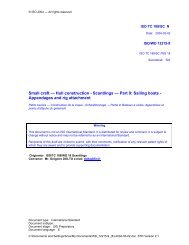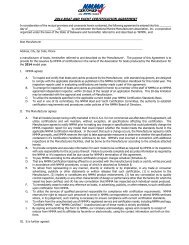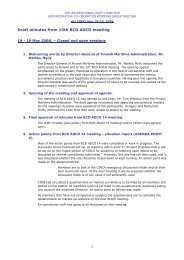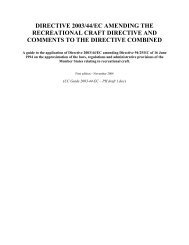Intellectual Property Protection and Enforcement Manual - Ipr-policy.eu
Intellectual Property Protection and Enforcement Manual - Ipr-policy.eu
Intellectual Property Protection and Enforcement Manual - Ipr-policy.eu
Create successful ePaper yourself
Turn your PDF publications into a flip-book with our unique Google optimized e-Paper software.
Br<strong>and</strong> <strong>Protection</strong> <strong>Manual</strong><br />
Microsoft<br />
Microsoft is the world’s largest software company, with nearly 90,000 employees in<br />
more than 100 countries <strong>and</strong> annual revenues exceeding $60 billion. The company<br />
develops a variety of products <strong>and</strong> services, including the popular Microsoft Windows<br />
operating system <strong>and</strong> the Microsoft Office suite of business software applications. The<br />
company’s global success, however, has attracted the attention of international criminals seeking<br />
to capitalize on the popularity of the company’s products. Software piracy costs the global<br />
economy billions of dollars each year, undermines innovation <strong>and</strong> local economic growth, <strong>and</strong><br />
poses serious risks to Microsoft’s customers <strong>and</strong> partners worldwide.<br />
So how does the software giant tackle the complex issues posed by software counterfeiting<br />
<strong>and</strong> piracy “Our global anti-piracy strategy is designed to protect our customers <strong>and</strong> partners<br />
around the world from the threat of software piracy through our Genuine Software Initiative.<br />
This initiative is based on three E’s—engineering, education, <strong>and</strong> enforcement,” says David<br />
Finn, associate general counsel for Worldwide Anti-Piracy <strong>and</strong> Anti-Counterfeiting. “We<br />
engineer products to make them difficult to counterfeit <strong>and</strong> pirate, educate our customers <strong>and</strong><br />
partners about counterfeiting <strong>and</strong> piracy, <strong>and</strong> take balanced civil <strong>and</strong> criminal enforcement<br />
action to shut down the pirates.”<br />
ENGINEERING<br />
On the engineering front, Microsoft has made significant investments in world-class security<br />
features <strong>and</strong> technologies. One example of this is Microsoft’s product activation technology,<br />
which is designed to limit illegal copying of software <strong>and</strong> provides customers with their own<br />
unique key for support <strong>and</strong> services. “We know we can’t do this by ourselves, so we’ve teamed<br />
up with pioneers in disk <strong>and</strong> print security,” says Finn. Those pioneers include companies like<br />
Technicolor, which produces Microsoft CDs <strong>and</strong> DVDs using highly proprietary embedded<br />
holographic disk technology that makes the disks extremely difficult to successfully counterfeit.<br />
Microsoft also works closely with international secure print manufacturers that supply<br />
Microsoft with the latest security technologies for its paper software licenses, certificate of<br />
authenticity labels, <strong>and</strong> other packaging. As Finn points out, “These technological advances,<br />
along with improved education <strong>and</strong> awareness-building efforts, make it easier for our<br />
consumers to spot a fake.”<br />
Microsoft’s experience shows that consumers have a major stake in doing their part to purchase<br />
<strong>and</strong> use genuine Microsoft software. Nightmarish stories abound about people who bought<br />
pirated software just to save a few dollars <strong>and</strong> then ended up paying an even bigger price down<br />
the road. “Pirated software can contain unknown security vulnerabilities or simply not work at<br />
all,” Finn explains. “Some counterfeit software has even been found to contain viruses, Trojans,<br />
Page 35











